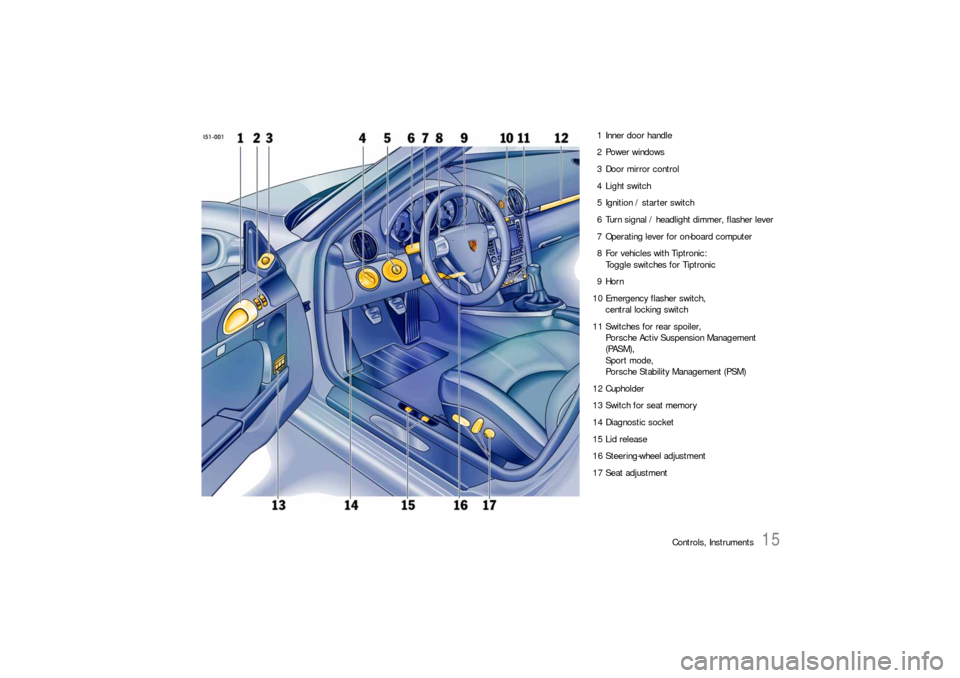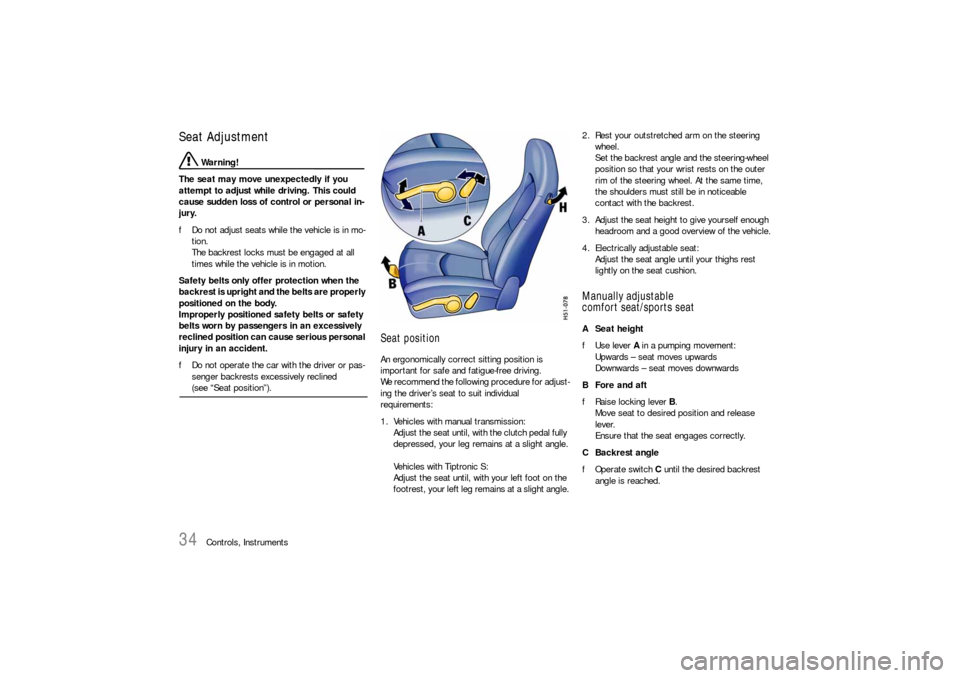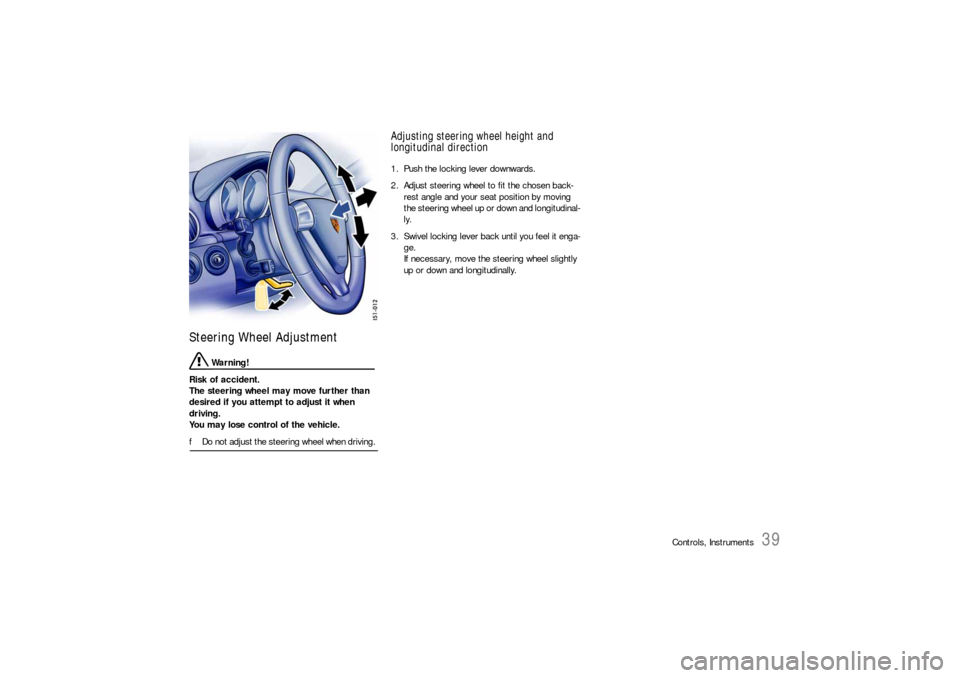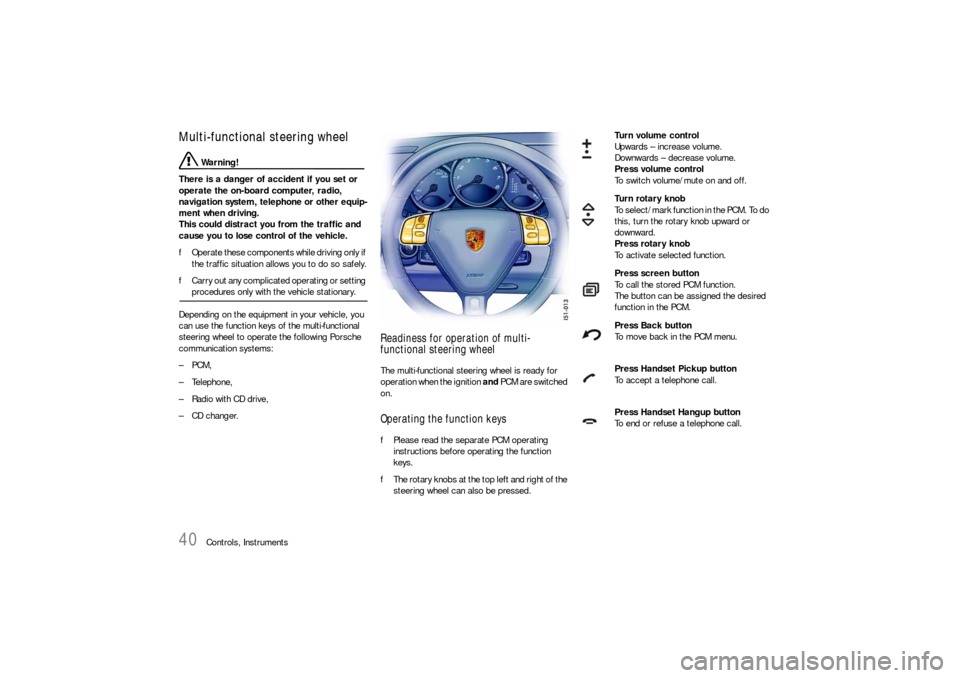wheel PORSCHE BOXSTER 2005 2.G Owners Manual
[x] Cancel search | Manufacturer: PORSCHE, Model Year: 2005, Model line: BOXSTER, Model: PORSCHE BOXSTER 2005 2.GPages: 276, PDF Size: 4.05 MB
Page 5 of 276

5
Tire Pressures for Cold Tires Summer tires and snow tires These tire pressures are valid only for Porsche approved tires.
For replacement tires it is imperative that you consult the Technical Data and Tires, Wheels
sections of this manual and follow the recommendations found there. 17 inch wheels front 29 psi (2.0 bar)
rear 36 psi (2.5 bar)
18 inch wheels front 29 psi (2.0 bar)
rear 36 psi (2.5 bar)
19 inch wheels front 32 psi (2.2 bar)
rear 36 psi (2.5 bar)
Page 11 of 276

Controls, Instruments
11 Controls, Instruments
Before driving off .......................................... 12
Break in hints for the first
2,000 miles/3,000 kilometers ...................... 14
Keys ........................................................... 17
Security Wheel Bolts .................................... 17
Central Locking in Cars
without Alarm System................................... 19
Doors ......................................................... 25
Alarm System,
Passenger Compartment Monitoring ............. 26
Power Windows ........................................... 28
Inside mirror ................................................ 30
Automatic Anti-Glare
Interior Mirror and Door Mirrors .................... 30
Door Mirrors................................................ 31
Seat Adjustment .......................................... 34
Seat Memory ............................................... 36
Heated Seats .............................................. 38
Steering Wheel Adjustment ........................... 39
Multi-functional steering wheel....................... 40
Sun Visors................................................... 41
Safety Belts................................................. 42
Child Restraint Systems................................ 45
Key-operated airbag deactivation device ........ 46
LATCH System
Child seat bracket on the passenger’s seat .... 47
Key-operated airbag deactivation device ........ 48
Airbag Systems ........................................... 49
Clutch Pedal ................................................ 51
Parking Brake .............................................. 51
Brakes ........................................................ 52ABS Brake System
(Antilock Brake System) ................................ 55
Sport Mode ................................................. 57
Porsche Stability Management (PSM)............. 58
Porsche Active Suspension Management
(PASM) ........................................................ 61
Retractable Spoiler ...................................... 62
Parking Aids ................................................ 64
Ignition/Starter Switch with anti-theft Steering
Lock ........................................................... 67
Starting Procedures ..................................... 69
Stopping engine........................................... 70
Instrument Panel USA Models ....................... 73
Automatic Speed Control Indicator light ......... 76
Instrument Illumination.................................. 76
Trip Odometer ............................................. 77
Speedometer .............................................. 78
Changing over between
Miles / Kilometers........................................ 78
Tachometer ................................................. 79
Turn Signal Indicator Light ............................ 79
High Beam .................................................. 79
Cooling System ........................................... 80
Tiptronic ...................................................... 81
Fuel ............................................................ 82
Clock .......................................................... 83
Outside temperature .................................... 83
Check Engine Warning Light.......................... 84
Central warning light .................................... 85
Brake warning light USA ............................... 85
Brake warning light Canada .......................... 85On-Board Computer (BC)............................... 86
Light Switch .............................................. 108
Welcome Home Lighting............................. 108
Automatic Headlight Beam Adjustment......... 109
Turn Signal/ Headlight Dimmer/Parking light /
Flasher Lever............................................. 109
Windshield Wiper / Washer Lever ................ 110
Automatic Speed Control ............................ 112
Air conditioning .......................................... 114
Automatic air conditioning system ............... 117
Central and side vents................................ 120
Fresh-air intake .......................................... 120
Emergency Flasher Switch .......................... 121
Ashtray ..................................................... 122
Cigarette Lighter ........................................ 123
Sockets .................................................... 124
Interior lights ............................................. 125
Storage in the passenger compartment ....... 126
Cupholder
(holder for drinks cans and cups) ................ 128
Luggage Storage on
Engine Compartment Lid ............................. 130
Fire extinguisher ........................................ 131
Trunk Entrapment ...................................... 132
Luggage compartment lids ......................... 134
Luggage Compartment.............................. 136
Rear luggage compartment ........................ 137
Porsche Communication Management
(PCM) ........................................................ 138
Car Audio Operation/Tips ........................... 139
HomeLink .................................................. 142
Page 12 of 276

12
Controls, Instruments
Dear Porsche Owner A lot has gone into the manufacture of your
Porsche, including advanced engineering, rigid
quality control and demanding inspections.
These engineering and safety features will be
enhanced by you... the safe driver... – who knows his car and all controls,
– who maintains the vehicle properly,
– who uses driving skills wisely, and always
drives within her/his own capabilities and the
level of familiarity with the vehicle.
You will find helpful hints in this manual on how to
perform most of the checks listed on the following
pages.
If in doubt, have these checks performed by your
authorized Porsche dealer.
Before driving off... Check the following items first fTurn the engine off before you attempt any
checks or repairs on the vehicle.
fBe sure the tires are inflated correctly.
Check tires for damage and tire wear.
fSee that wheel bolts are properly tightened
and not loose or missing.
fCheck engine oil level, add if necessary.
Make it a habit to have engine oil checked with
every fuel filling.
fCheck all fluid levels such as windshield was-
her and brake fluid levels.
fBe sure the vehicle battery is well charged and
cranks the engine properly.
fCheck all doors and lids for proper operation
and latch them properly.
fCheck and if necessary replace worn or cra-
cked wiper blades.
fSee that all windows are clear and unobstruc-
ted.
fCheck air intake slots and area between front
lid and windshield are free of snow and ice, so
the heater and the windshield wipers work pro-
perly. fIf a child will be riding in the vehicle, check
child seat/child seat restraint system to ensure
that restraints are properly adjusted.
fCheck all exterior and interior lights for opera-
tion and that the lenses are clean.
fCheck the headlights for proper aim, and if ne-
cessary, have them adjusted.
fCheck under the vehicle for leaks.
fBe sure all luggage is stowed securely.
Emergency equipment It is good practice to carry emergency equipment
in your vehicle.
Some of the items you should have are:
window scraper, snow brush, container or bag of
sand or salt, emergency light, small shovel, first-
aid kit, etc.
Page 13 of 276

Controls, Instruments
13
In the driver’s seat... fCheck operation of the horn.
fPosition seat for easy reach of foot pedals and
controls.
To reduce the possibility of injury from the air-
bag deployment, you should always sit back as
far from the steering wheel as is practical,
while still maintaining full vehicle control.
fAdjust the inside and outside rear view mirrors.
fBuckle your safety belts.
fCheck operation of the foot and parking brake.
fCheck all warning and indicator lights with
ignition on and engine not running.
fStart engine and check all warning displays for
warning symbols.
fNever leave an idling car unattended.
fLock doors from inside, especially with child-
ren in the car to prevent inadvertent opening of
doors from inside or outside.
Drive with doors locked.
On the road... fNever drive after you have consumed alcohol
or drugs.
fAlways have your safety belt fastened.
fAlways drive defensively.
Expect the unexpected.
fUse signals to indicate turns and lane changes.
fTurn on headlights at dusk or when the driving
conditions warrant it.
fAlways keep a safe distance from the vehicle in
front of you, depending on traffic, road and
weather conditions.
fReduce speed at night and during inclement
weather.
Driving in wet weather requires caution and re-
duced speeds, particularly on roads with stan-
ding water, as the handling characteristics of
the vehicle may be impaired due to hydropla-
ning of the tires.
fAlways observe speed limits and obey road
signs and traffic laws.
fWhen tired, get well off the road, stop and take
a rest. Turn the engine off. Do not sit in the ve-
hicle with engine idling.
fPlease observe the chapter “ENGINE EX-
HAUST” on Page 8.fWhen parked, always set the parking brake.
Move the Tiptronic selector lever to ”P“ or the
gearshift lever to reverse or first gear.
On hills also turn the front wheels toward the
curb.
fWhen emergency repairs become necessary,
move the vehicle well off the road. Turn on the
emergency flasher and use other warning de-
vices to alert other motorists. Do not park or
operate the vehicle in areas where the hot ex-
haust system may come in contact with dry
grass, brush, fuel spill or other flammable ma-
terial.
fMake it a habit to have the engine oil checked
with every fuel filling.
Danger!
Danger of fire in engine compartment due to
burning cigars or cigarettes.
fDo not throw any lit cigars or cigarettes out of
the vehicle.
They can be blown into the air inlets by the air
flow and cause a fire in the engine compart-
ment.
fPlease observe the chapter “ASHTRAY” on Page 122.
Page 15 of 276

Controls, Instruments
15
1 Inner door handle
2 Power windows
3 Door mirror control
4 Light switch
5 Ignition / starter switch
6 Turn signal / headlight dimmer, flasher lever
7 Operating lever for on-board computer
8 For vehicles with Tiptronic:
Toggle switches for Tiptronic
9Horn
10 Emergency flasher switch,
central locking switch
11 Switches for rear spoiler,
Porsche Activ Suspension Management
(PASM),
Sport mode,
Porsche Stability Management (PSM)
12 Cupholder
13 Switch for seat memory
14 Diagnostic socket
15 Lid release
16 Steering-wheel adjustment
17 Seat adjustment
Page 16 of 276

16
Controls, Instruments
Never invite car theft! An unlocked car with the key in the ignition lock in-
vites car theft.
A steering wheel lock and a gong alarm are stan-
dard equipment in your Porsche.
The gong alarm will sound if you open the driver’s
door while the key is still in the ignition lock. It is
your reminder to pull the key out of the ignition
lock and to lock the doors.
Warning!
Any uncontrolled movement of the vehicle
may result in serious personal injury and pro-
perty damage.
Never leave your vehicle unattended with the
key in the ignition lock, especially if children
and/or pets are left unattended in the vehic-
le. They can operate power windows and
other controls. If the engine is left running,
they may accidentally engage the shift lever.
fAlways remove the ignition key.
fAlways set the parking brake.
fLock the doors with the key or with the remote control.
Warning!
Risk of a serious accident.
The steering column will lock when you re-
move the key while you are driving or as the
car is rolling to a stop. You will not be able to
steer the car.
fNever remove the key from the steering lock while you are driving. To protect your vehicle and your possessions
from theft, you should always proceed as fol-
lows when leaving your vehicle:
fClose windows.
fClose convertible top
(with the convertible top open, the passenger
compartment monitoring system is always
switched off).
fLock glove compartment.
fRemove ignition key.
fClose storage tray between the seats.
fRemove valuables (e.g. car documents, tele-
phone, house keys) from the car.
fLock doors.
Page 17 of 276

Controls, Instruments
17
Keys fPlease observe the chapter “CENTRAL LO-
CKING IN CARS WITH ALARM SYSTEM” on
Page 21.
Two main keys and one spare key are supplied
with your Porsche.
These keys operate all the locks on your vehicle.
fBe careful with your car keys: do not part with
them except under exceptional circumstances.
fTo avoid battery run-down, always remove the
ignition key from the ignition lock.
Replacement keys Replacement car keys can be obtained only from
your authorized Porsche dealer, and this can so-
metimes be very time-consuming.
You should therefore always keep the spare key on
your person.
Keep it in a safe place (e.g. wallet), but under no
circumstances in or on the vehicle.
The key codes of new keys have to be “reported”
to the car control unit by your authorized Porsche
dealer.
The key grip of the spare key can be exchanged
for a main-key grip.
Disabling key codes
If a key is lost, the key codes can be disabled by
an authorized Porsche dealer.
All the remaining car keys are required for this pur-
pose.
Disabling the code ensures that the car can be
started only using authorized keys.
Note
fPlease note that the other locks can still be
opened with the disabled key.
Immobilizer There is a transponder (an electronic component)
in the key grip, containing a stored code.
When the ignition is switched on, the ignition lock
checks the code.
The immobilizer can be deactivated and the engi-
ne started only using an authorized ignition key.
Switching off the immobilizer
fInsert the ignition key into the ignition lock.
If the ignition is left on for more than 2 minutes
without starting the engine, the immobilizer is re-
activated.
fIf this happens, turn the ignition key back to the
3 position before starting the engine.
Please observe the chapter “IGNITION/STAR-
TER SWITCH WITH ANTI-THEFT STEERING
LOCK” on Page 68.
Switching off the immobilizer
fRemove ignition key.Security Wheel Bolts fIf wheels have to be removed during a work-
shop visit, do not forget to hand over the so-
cket for the security wheel bolts along with the
car key.
Page 34 of 276

34
Controls, Instruments
Seat Adjustment
Warning!
The seat may move unexpectedly if you
attempt to adjust while driving. This could
cause sudden loss of control or personal in-
jury.
fDo not adjust seats while the vehicle is in mo-
tion.
The backrest locks must be engaged at all
times while the vehicle is in motion.
Safety belts only offer protection when the
backrest is upright and the belts are properly
positioned on the body.
Improperly positioned safety belts or safety
belts worn by passengers in an excessively
reclined position can cause serious personal
injury in an accident.
fDo not operate the car with the driver or pas-
senger backrests excessively reclined (see “Seat position”).
Seat position An ergonomically correct sitting position is
important for safe and fatigue-free driving.
We recommend the following procedure for adjust-
ing the driver’s seat to suit individual
requirements:
1. Vehicles with manual transmission:
Adjust the seat until, with the clutch pedal fully
depressed, your leg remains at a slight angle.
Vehicles with Tiptronic S:
Adjust the seat until, with your left foot on the
footrest, your left leg remains at a slight angle.2. Rest your outstretched arm on the steering
wheel.
Set the backrest angle and the steering-wheel
position so that your wrist rests on the outer
rim of the steering wheel. At the same time,
the shoulders must still be in noticeable
contact with the backrest.
3. Adjust the seat height to give yourself enough
headroom and a good overview of the vehicle.
4. Electrically adjustable seat:
Adjust the seat angle until your thighs rest
lightly on the seat cushion.
Manually adjustable
comfort seat/sports seatA Seat height
fUse lever A in a pumping movement:
Upwards – seat moves upwards
Downwards – seat moves downwards
B Fore and aft
fRaise locking lever B.
Move seat to desired position and release
lever.
Ensure that the seat engages correctly.
CBackrest angle
fOperate switch C until the desired backrest
angle is reached.
Page 39 of 276

Controls, Instruments
39
Steering Wheel Adjustment
Warning!
Risk of accident.
The steering wheel may move further than
desired if you attempt to adjust it when
driving.
You may lose control of the vehicle.
fDo not adjust the steering wheel when driving.
Adjusting steering wheel height and
longitudinal direction 1. Push the locking lever downwards.
2. Adjust steering wheel to fit the chosen back-
rest angle and your seat position by moving
the steering wheel up or down and longitudinal-
ly.
3. Swivel locking lever back until you feel it enga-
ge.
If necessary, move the steering wheel slightly
up or down and longitudinally.
Page 40 of 276

40
Controls, Instruments
Multi-functional steering wheel
Warning!
There is a danger of accident if you set or
operate the on-board computer, radio,
navigation system, telephone or other equip-
ment when driving.
This could distract you from the traffic and
cause you to lose control of the vehicle.
fOperate these components while driving only if
the traffic situation allows you to do so safely.
fCarry out any complicated operating or setting procedures only with the vehicle stationary.
Depending on the equipment in your vehicle, you
can use the function keys of the multi-functional
steering wheel to operate the following Porsche
communication systems:
–PCM,
– Telephone,
– Radio with CD drive,
–CD changer.
Readiness for operation of multi-
functional steering wheelThe multi-functional steering wheel is ready for
operation when the ignition and PCM are switched
on.Operating the function keysfPlease read the separate PCM operating
instructions before operating the function
keys.
fThe rotary knobs at the top left and right of the
steering wheel can also be pressed.
Turn volume control
Upwards – increase volume.
Downwards – decrease volume.
Press volume control
To switch volume/mute on and off.
Turn rotary knob
To select/mark function in the PCM. To do
this, turn the rotary knob upward or
downward.
Press rotary knob
To activate selected function.
Press screen button
To call the stored PCM function.
The button can be assigned the desired
function in the PCM.
Press Back button
To move back in the PCM menu.
Press Handset Pickup button
To accept a telephone call.
Press Handset Hangup button
To end or refuse a telephone call.